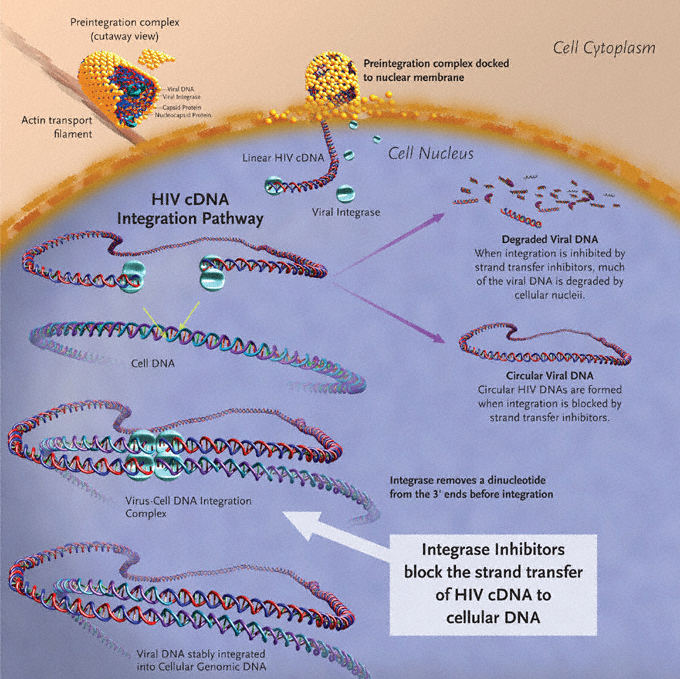
Integrase inhibitors (also known as integrase strand transfer inhibitors, or INSTIs) are a powerful class of antiretroviral drug which prevents HIV from integrating its genetic coding (genome) into the DNA of the infected host cell. It does so by blocking an enzyme called integrase and, by doing so, makes it impossible for HIV to replicate.
As a class of drugs, integrase inhibitors are considered advantageous in treating HIV infection, with easier dosing requirements, lower side effects, improved resistance profiles, and greater durability.
Current guidance from the U.S. Department of Health and Human Services places integrase inhibitors as a preferred, first-line agent for persons newly treated for HIV. In fact, of the six treatment options currently recommended for newly treated patients, five contain an integrase inhibitor as their backbone drug agent.
Mechanism
HIV integrates its viral genome into the host cell's DNA in a five-step process:
The integrase enzyme binds to HIV DNA, the latter of which is created in a process called reverse transcription.
The HIV DNA is then prepared for integration in a process called cleaving, which literally cleaves the viral genetic strand, leaving open gaps in its structure.
The cleaved strand is then inserted into the host cell's nucleus through a nuclear pore.
Once inside the nucleus, the HIV DNA is transferred into the host DNA in is what's called a strand transfer reaction. In this stage, the viral DNA the literally attacks the host cell's DNA, separating the bonds that hold the host DNA together and attaching itself through the chemical gaps in the viral DNA strand.
The attack then incites a natural protective response called gap repair, in which the host cell will automatically repair any damage to the DNA, essentially facilitating the takeover of its genetic coding.
Simply by blocking the integrase enzyme, the entire integration process is stopped, effectively ending the virus' life cycle. However, as integration is only one of several stages of the HIV life cycles, other drugs are taken to inhibit other stages, further preventing HIV from replicating and ensuring that viral activity is fully suppressed (as measured by the HIV viral load).
Side Effects and Considerations
Unlike other classes of HIV drug, integrase inhibitors work directly on the viral mechanisms themselves rather than on cells. As such, they tend have far fewer side effect, primarily diarrhoea, nausea, fatigue, headache, and insomnia.
Most of these side effects, however, are transient and usually resolve on their own. With that being said, if you experience any adverse event while taking an integrase inhibitor drug combination, advise your doctor or clinic immediately. Do not stop treatment without at least speaking to a qualified professional. Stopping and changing prematurely can do more harm than good.
Similarly, while integrase inhibitors are less to prone to premature drug resistance, you should avoid missing doses or gaps in treatment. Resistance occurs when drug levels in the blood begin to fall, allowing mutant viruses to emerge and proliferate. When this happens, your drugs will not be able to work as well as before and may, in some cases, fail.
Since integrase inhibitors remain in the blood stream for longer periods of time, they are able to suppress HIV mutants even when doses are occasionally missed. But it's important to understand that prolonged interruptions are ill advised and that daily adherence remain key to treatment success.
Source: https://www.verywellhealth.com/integrase-inhibitors-48802
To submit your abstracts, please visit:https://std-hiv-aids.cmesociety.com/abstract-submission




No comments:
Post a Comment